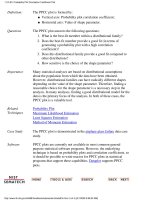Engineering Statistics Handbook Episode 1 Part 14 potx
Bạn đang xem bản rút gọn của tài liệu. Xem và tải ngay bản đầy đủ của tài liệu tại đây (101.8 KB, 20 trang )
*********************************************************
** normal Kolmogorov-Smirnov goodness of fit test y3 **
*********************************************************
KOLMOGOROV-SMIRNOV GOODNESS-OF-FIT TEST
NULL HYPOTHESIS H0: DISTRIBUTION FITS THE DATA
ALTERNATE HYPOTHESIS HA: DISTRIBUTION DOES NOT FIT THE DATA
DISTRIBUTION: NORMAL
NUMBER OF OBSERVATIONS = 1000
TEST:
KOLMOGOROV-SMIRNOV TEST STATISTIC = 0.6119353E-01
ALPHA LEVEL CUTOFF CONCLUSION
10% 0.03858 REJECT H0
5% 0.04301 REJECT H0
1% 0.05155 REJECT H0
*********************************************************
** normal Kolmogorov-Smirnov goodness of fit test y4 **
*********************************************************
KOLMOGOROV-SMIRNOV GOODNESS-OF-FIT TEST
NULL HYPOTHESIS H0: DISTRIBUTION FITS THE DATA
ALTERNATE HYPOTHESIS HA: DISTRIBUTION DOES NOT FIT THE DATA
DISTRIBUTION: NORMAL
NUMBER OF OBSERVATIONS = 1000
TEST:
KOLMOGOROV-SMIRNOV TEST STATISTIC = 0.5354889
ALPHA LEVEL CUTOFF CONCLUSION
10% 0.03858 REJECT H0
5% 0.04301 REJECT H0
1% 0.05155 REJECT H0
Questions The Kolmogorov-Smirnov test can be used to answer the following types of
questions:
Are the data from a normal distribution?
●
Are the data from a log-normal distribution?●
Are the data from a Weibull distribution?●
Are the data from an exponential distribution?●
Are the data from a logistic distribution?●
1.3.5.16. Kolmogorov-Smirnov Goodness-of-Fit Test
(5 of 6) [5/1/2006 9:57:47 AM]
Importance Many statistical tests and procedures are based on specific distributional
assumptions. The assumption of normality is particularly common in classical
statistical tests. Much reliability modeling is based on the assumption that the
data follow a Weibull distribution.
There are many non-parametric and robust techniques that are not based on strong
distributional assumptions. By non-parametric, we mean a technique, such as the
sign test, that is not based on a specific distributional assumption. By robust, we
mean a statistical technique that performs well under a wide range of
distributional assumptions. However, techniques based on specific distributional
assumptions are in general more powerful than these non-parametric and robust
techniques. By power, we mean the ability to detect a difference when that
difference actually exists. Therefore, if the distributional assumptions can be
confirmed, the parametric techniques are generally preferred.
If you are using a technique that makes a normality (or some other type of
distributional) assumption, it is important to confirm that this assumption is in
fact justified. If it is, the more powerful parametric techniques can be used. If the
distributional assumption is not justified, using a non-parametric or robust
technique may be required.
Related
Techniques
Anderson-Darling goodness-of-fit Test
Chi-Square goodness-of-fit Test
Shapiro-Wilk Normality Test
Probability Plots
Probability Plot Correlation Coefficient Plot
Case Study
Airplane glass failure times data
Software
Some general purpose statistical software programs, including Dataplot, support
the Kolmogorov-Smirnov goodness-of-fit test, at least for some of the more
common distributions.
1.3.5.16. Kolmogorov-Smirnov Goodness-of-Fit Test
(6 of 6) [5/1/2006 9:57:47 AM]
with Y
min
denoting the minimum value.
test whether the maximum value is an outlier
with Y
max
denoting the maximum value.
2.
Significance
Level:
.
Critical
Region:
For the two-sided test, the hypothesis of no outliers is
rejected if
with denoting the critical value of the
t-distribution with (N-2)/2 degrees of freedom and a
significance level of
/(2N).
For the one-sided tests, we use a significance level of
/N.
In the above formulas for the critical regions, the
Handbook follows the convention that is the upper
critical value from the t-distribution and
is the
lower critical value from the t-distribution. Note that this
is the opposite of what is used in some texts and software
programs. In particular, Dataplot uses the opposite
convention.
Sample
Output
Dataplot generated the following output for the ZARR13.DAT data set
showing that Grubbs' test finds no outliers in the dataset:
*********************
** grubbs test y **
*********************
GRUBBS TEST FOR OUTLIERS
(ASSUMPTION: NORMALITY)
1. STATISTICS:
NUMBER OF OBSERVATIONS = 195
MINIMUM = 9.196848
MEAN = 9.261460
1.3.5.17. Grubbs' Test for Outliers
(2 of 4) [5/1/2006 9:57:48 AM]
MAXIMUM = 9.327973
STANDARD DEVIATION = 0.2278881E-01
GRUBBS TEST STATISTIC = 2.918673
2. PERCENT POINTS OF THE REFERENCE DISTRIBUTION
FOR GRUBBS TEST STATISTIC
0 % POINT = 0.000000
50 % POINT = 2.984294
75 % POINT = 3.181226
90 % POINT = 3.424672
95 % POINT = 3.597898
97.5 % POINT = 3.763061
99 % POINT = 3.970215
100 % POINT = 13.89263
3. CONCLUSION (AT THE 5% LEVEL):
THERE ARE NO OUTLIERS.
Interpretation
of Sample
Output
The output is divided into three sections.
The first section prints the sample statistics used in the
computation of the Grubbs' test and the value of the Grubbs' test
statistic.
1.
The second section prints the upper critical value for the Grubbs'
test statistic distribution corresponding to various significance
levels. The value in the first column, the confidence level of the
test, is equivalent to 100(1-
). We reject the null hypothesis at
that significance level if the value of the Grubbs' test statistic
printed in section one is greater than the critical value printed in
the last column.
2.
The third section prints the conclusion for a 95% test. For a
different significance level, the appropriate conclusion can be
drawn from the table printed in section two. For example, for
= 0.10, we look at the row for 90% confidence and compare the
critical value 3.24 to the Grubbs' test statistic 2.92. Since the test
statistic is less than the critical value, we accept the null
hypothesis at the
= 0.10 level.
3.
Output from other statistical software may look somewhat different
from the above output.
Questions Grubbs' test can be used to answer the following questions:
Does the data set contain any outliers?1.
How many outliers does it contain?2.
1.3.5.17. Grubbs' Test for Outliers
(3 of 4) [5/1/2006 9:57:48 AM]
Importance Many statistical techniques are sensitive to the presence of outliers. For
example, simple calculations of the mean and standard deviation may
be distorted by a single grossly inaccurate data point.
Checking for outliers should be a routine part of any data analysis.
Potential outliers should be examined to see if they are possibly
erroneous. If the data point is in error, it should be corrected if possible
and deleted if it is not possible. If there is no reason to believe that the
outlying point is in error, it should not be deleted without careful
consideration. However, the use of more robust techniques may be
warranted. Robust techniques will often downweight the effect of
outlying points without deleting them.
Related
Techniques
Several graphical techniques can, and should, be used to detect
outliers. A simple run sequence plot, a box plot, or a histogram should
show any obviously outlying points.
Run Sequence Plot
Histogram
Box Plot
Normal Probability Plot
Lag Plot
Case Study
Heat flow meter data.
Software Some general purpose statistical software programs, including
Dataplot, support the Grubbs' test.
1.3.5.17. Grubbs' Test for Outliers
(4 of 4) [5/1/2006 9:57:48 AM]
Yates
Order
Before performing a Yates analysis, the data should be arranged in "Yates order". That
is, given k factors, the kth column consists of 2
k-1
minus signs (i.e., the low level of the
factor) followed by 2
k-1
plus signs (i.e., the high level of the factor). For example, for
a full factorial design with three factors, the design matrix is
- - -
+ - -
- + -
+ + -
- - +
+ - +
- + +
+ + +
Determining the Yates order for fractional factorial designs requires knowledge of the
confounding structure of the fractional factorial design.
Yates
Output
A Yates analysis generates the following output.
A factor identifier (from Yates order). The specific identifier will vary
depending on the program used to generate the Yates analysis. Dataplot, for
example, uses the following for a 3-factor model.
1 = factor 1
2 = factor 2
3 = factor 3
12 = interaction of factor 1 and factor 2
13 = interaction of factor 1 and factor 3
23 = interaction of factor 2 and factor 3
123 =interaction of factors 1, 2, and 3
1.
Least squares estimated factor effects ordered from largest in magnitude (most
significant) to smallest in magnitude (least significant).
That is, we obtain a ranked list of important factors.
2.
A t-value for the individual factor effect estimates. The t-value is computed as
where e is the estimated factor effect and is the standard deviation of the
estimated factor effect.
3.
The residual standard deviation that results from the model with the single term
only. That is, the residual standard deviation from the model
response = constant + 0.5 (X
i
)
4.
1.3.5.18. Yates Analysis
(2 of 5) [5/1/2006 9:57:48 AM]
where X
i
is the estimate of the ith factor or interaction effect.
The cumulative residual standard deviation that results from the model using the
current term plus all terms preceding that term. That is,
response = constant + 0.5 (all effect estimates down to and including the
effect of interest)
This consists of a monotonically decreasing set of residual standard deviations
(indicating a better fit as the number of terms in the model increases). The first
cumulative residual standard deviation is for the model
response = constant
where the constant is the overall mean of the response variable. The last
cumulative residual standard deviation is for the model
response = constant + 0.5*(all factor and interaction estimates)
This last model will have a residual standard deviation of zero.
5.
Sample
Output
Dataplot generated the following Yates analysis output for the Eddy current data set:
(NOTE DATA MUST BE IN STANDARD ORDER)
NUMBER OF OBSERVATIONS = 8
NUMBER OF FACTORS = 3
NO REPLICATION CASE
PSEUDO-REPLICATION STAND. DEV. = 0.20152531564E+00
PSEUDO-DEGREES OF FREEDOM = 1
(THE PSEUDO-REP. STAND. DEV. ASSUMES ALL
3, 4, 5, TERM INTERACTIONS ARE NOT REAL,
BUT MANIFESTATIONS OF RANDOM ERROR)
STANDARD DEVIATION OF A COEF. = 0.14249992371E+00
(BASED ON PSEUDO-REP. ST. DEV.)
GRAND MEAN = 0.26587500572E+01
GRAND STANDARD DEVIATION = 0.17410624027E+01
99% CONFIDENCE LIMITS (+-) = 0.90710897446E+01
95% CONFIDENCE LIMITS (+-) = 0.18106349707E+01
99.5% POINT OF T DISTRIBUTION = 0.63656803131E+02
97.5% POINT OF T DISTRIBUTION = 0.12706216812E+02
IDENTIFIER EFFECT T VALUE RESSD: RESSD:
MEAN + MEAN +
TERM CUM TERMS
1.3.5.18. Yates Analysis
(3 of 5) [5/1/2006 9:57:48 AM]
MEAN 2.65875 1.74106 1.74106
1 3.10250 21.8* 0.57272 0.57272
2 -0.86750 -6.1 1.81264 0.30429
23 0.29750 2.1 1.87270 0.26737
13 0.24750 1.7 1.87513 0.23341
3 0.21250 1.5 1.87656 0.19121
123 0.14250 1.0 1.87876 0.18031
12 0.12750 0.9 1.87912 0.00000
Interpretation
of Sample
Output
In summary, the Yates analysis provides us with the following ranked
list of important factors along with the estimated effect estimate.
X1:1. effect estimate = 3.1025 ohms
X2:2. effect estimate = -0.8675 ohms
X2*X3:3. effect estimate = 0.2975 ohms
X1*X3:4. effect estimate = 0.2475 ohms
X3:5. effect estimate = 0.2125 ohms
X1*X2*X3:6. effect estimate = 0.1425 ohms
X1*X2:7. effect estimate = 0.1275 ohms
Model
Selection and
Validation
From the above Yates output, we can define the potential models from
the Yates analysis. An important component of a Yates analysis is
selecting the best model from the available potential models.
Once a tentative model has been selected, the error term should follow
the assumptions for a univariate measurement process. That is, the
model should be validated by analyzing the residuals.
Graphical
Presentation
Some analysts may prefer a more graphical presentation of the Yates
results. In particular, the following plots may be useful:
Ordered data plot1.
Ordered absolute effects plot2.
Cumulative residual standard deviation plot3.
Questions The Yates analysis can be used to answer the following questions:
What is the ranked list of factors?1.
What is the goodness-of-fit (as measured by the residual
standard deviation) for the various models?
2.
1.3.5.18. Yates Analysis
(4 of 5) [5/1/2006 9:57:48 AM]
Related
Techniques
Multi-factor analysis of variance
Dex mean plot
Block plot
Dex contour plot
Case Study
The Yates analysis is demonstrated in the Eddy current case study.
Software Many general purpose statistical software programs, including
Dataplot, can perform a Yates analysis.
1.3.5.18. Yates Analysis
(5 of 5) [5/1/2006 9:57:48 AM]
97.5% POINT OF T DISTRIBUTION = 0.12706216812E+02
IDENTIFIER EFFECT T VALUE RESSD: RESSD:
MEAN + MEAN +
TERM CUM TERMS
MEAN 2.65875 1.74106 1.74106
1 3.10250 21.8* 0.57272 0.57272
2 -0.86750 -6.1 1.81264 0.30429
23 0.29750 2.1 1.87270 0.26737
13 0.24750 1.7 1.87513 0.23341
3 0.21250 1.5 1.87656 0.19121
123 0.14250 1.0 1.87876 0.18031
12 0.12750 0.9 1.87912 0.00000
The last column of the Yates table gives the residual standard deviation for 8 possible
models, each with one more term than the previous model.
Potential
Models
For this example, we can summarize the possible prediction equations using the second
and last columns of the Yates table:
has a residual standard deviation of 1.74106 ohms. Note that this is the default
model. That is, if no factors are important, the model is simply the overall mean.
●
has a residual standard deviation of 0.57272 ohms. (Here, X1 is either a +1 or -1,
and similarly for the other factors and interactions (products).)
●
has a residual standard deviation of 0.30429 ohms.
●
has a residual standard deviation of 0.26737 ohms.
●
has a residual standard deviation of 0.23341 ohms
●
has a residual standard deviation of 0.19121 ohms.
●
1.3.5.18.1. Defining Models and Prediction Equations
(2 of 3) [5/1/2006 9:57:49 AM]
has a residual standard deviation of 0.18031 ohms.
●
has a residual standard deviation of 0.0 ohms. Note that the model with all
possible terms included will have a zero residual standard deviation. This will
always occur with an unreplicated two-level factorial design.
●
Model
Selection
The above step lists all the potential models. From this list, we want to select the most
appropriate model. This requires balancing the following two goals.
We want the model to include all important factors.1.
We want the model to be parsimonious. That is, the model should be as simple as
possible.
2.
Note that the residual standard deviation alone is insufficient for determining the most
appropriate model as it will always be decreased by adding additional factors. The next
section describes a number of approaches for determining which factors (and
interactions) to include in the model.
1.3.5.18.1. Defining Models and Prediction Equations
(3 of 3) [5/1/2006 9:57:49 AM]
Effects:
Engineering
Significance
The minimum engineering significant difference is defined as
where is the absolute value of the parameter estimate (i.e., the effect) and is the minimum
engineering significant difference.
That is, declare a factor as "important" if the effect is greater than some a priori declared
engineering difference. This implies that the engineering staff have in fact stated what a minimum
effect will be. Oftentimes this is not the case. In the absence of an a priori difference, a good
rough rule for the minimum engineering significant
is to keep only those factors whose effect
is greater than, say, 10% of the current production average. In this case, let's say that the average
detector has a sensitivity of 2.5 ohms. This would suggest that we would declare all factors whose
effect is greater than 10% of 2.5 ohms = 0.25 ohm to be significant (from an engineering point of
view).
Based on this minimum engineering significant difference criterion, we conclude that we should
keep two terms: X1 and X2.
Effects:
Order of
Magnitude
The order of magnitude criterion is defined as
That is, exclude any factor that is less than 10% of the maximum effect size. We may or may not
keep the other factors. This criterion is neither engineering nor statistical, but it does offer some
additional numerical insight. For the current example, the largest effect is from X1 (3.10250
ohms), and so 10% of that is 0.31 ohms, which suggests keeping all factors whose effects exceed
0.31 ohms.
Based on the order-of-magnitude criterion, we thus conclude that we should keep two terms: X1
and X2. A third term, X2*X3 (.29750), is just slightly under the cutoff level, so we may consider
keeping it based on the other criterion.
Effects:
Statistical
Significance
Statistical significance is defined as
That is, declare a factor as important if its effect is more than 2 standard deviations away from 0
(0, by definition, meaning "no effect").
The "2" comes from normal theory (more specifically, a value of 1.96 yields a 95% confidence
interval). More precise values would come from t-distribution theory.
The difficulty with this is that in order to invoke this criterion we need the standard deviation,
,
of an observation. This is problematic because
the engineer may not know
;1.
the experiment might not have replication, and so a model-free estimate of
is not
obtainable;
2.
obtaining an estimate of
by assuming the sometimes- employed assumption of ignoring
3-term interactions and higher may be incorrect from an engineering point of view.
3.
For the Eddy current example:
the engineer did not know
;1.
the design (a 2
3
full factorial) did not have replication;2.
1.3.5.18.2. Important Factors
(2 of 7) [5/1/2006 9:57:49 AM]
ignoring 3-term interactions and higher interactions leads to an estimate of based on
omitting only a single term: the X1*X2*X3 interaction.
3.
For the current example, if one assumes that the 3-term interaction is nil and hence represents a
single drawing from a population centered at zero, then an estimate of the standard deviation of
an effect is simply the estimate of the 3-factor interaction (0.1425). In the Dataplot output for our
example, this is the effect estimate for the X1*X2*X3 interaction term (the EFFECT column for
the row labeled "123"). Two standard deviations is thus 0.2850. For this example, the rule is thus
to keep all
> 0.2850.
This results in keeping three terms: X1 (3.10250), X2 ( 86750), and X1*X2 (.29750).
Effects:
Probability
Plots
Probability plots can be used in the following manner.
Normal Probability Plot: Keep a factor as "important" if it is well off the line through zero
on a normal probability plot of the effect estimates.
1.
Half-Normal Probability Plot: Keep a factor as "important" if it is well off the line near
zero on a half-normal probability plot of the absolute value of effect estimates.
2.
Both of these methods are based on the fact that the least squares estimates of effects for these
2-level orthogonal designs are simply the difference of averages and so the central limit theorem,
loosely applied, suggests that (if no factor were important) the effect estimates should have
approximately a normal distribution with mean zero and the absolute value of the estimates
should have a half-normal distribution.
Since the half-normal probability plot is only concerned with effect magnitudes as opposed to
signed effects (which are subject to the vagaries of how the initial factor codings +1 and -1 were
assigned), the half-normal probability plot is preferred by some over the normal probability plot.
Normal
Probablity
Plot of
Effects and
Half-Normal
Probability
Plot of
Effects
The following half-normal plot shows the normal probability plot of the effect estimates and the
half-normal probability plot of the absolute value of the estimates for the Eddy current data.
1.3.5.18.2. Important Factors
(3 of 7) [5/1/2006 9:57:49 AM]
For the example at hand, both probability plots clearly show two factors displaced off the line,
and from the third plot (with factor tags included), we see that those two factors are factor 1 and
factor 2. All of the remaining five effects are behaving like random drawings from a normal
distribution centered at zero, and so are deemed to be statistically non-significant. In conclusion,
this rule keeps two factors: X1 (3.10250) and X2 ( 86750).
Effects:
Youden Plot
A Youden plot can be used in the following way. Keep a factor as "important" if it is displaced
away from the central-tendancy "bunch" in a Youden plot of high and low averages. By
definition, a factor is important when its average response for the low (-1) setting is significantly
different from its average response for the high (+1) setting. Conversely, if the low and high
averages are about the same, then what difference does it make which setting to use and so why
would such a factor be considered important? This fact in combination with the intrinsic benefits
of the Youden plot for comparing pairs of items leads to the technique of generating a Youden
plot of the low and high averages.
1.3.5.18.2. Important Factors
(4 of 7) [5/1/2006 9:57:49 AM]
Youden Plot
of Effect
Estimatess
The following is the Youden plot of the effect estimatess for the Eddy current data.
For the example at hand, the Youden plot clearly shows a cluster of points near the grand average
(2.65875) with two displaced points above (factor 1) and below (factor 2). Based on the Youden
plot, we conclude to keep two factors: X1 (3.10250) and X2 ( 86750).
Residual
Standard
Deviation:
Engineering
Significance
This criterion is defined as
Residual Standard Deviation > Cutoff
That is, declare a factor as "important" if the cumulative model that includes the factor (and all
larger factors) has a residual standard deviation smaller than an a priori engineering-specified
minimum residual standard deviation.
This criterion is different from the others in that it is model focused. In practice, this criterion
states that starting with the largest effect, we cumulatively keep adding terms to the model and
monitor how the residual standard deviation for each progressively more complicated model
becomes smaller. At some point, the cumulative model will become complicated enough and
comprehensive enough that the resulting residual standard deviation will drop below the
pre-specified engineering cutoff for the residual standard deviation. At that point, we stop adding
terms and declare all of the model-included terms to be "important" and everything not in the
model to be "unimportant".
This approach implies that the engineer has considered what a minimum residual standard
deviation should be. In effect, this relates to what the engineer can tolerate for the magnitude of
the typical residual (= difference between the raw data and the predicted value from the model).
1.3.5.18.2. Important Factors
(5 of 7) [5/1/2006 9:57:49 AM]
In other words, how good does the engineer want the prediction equation to be. Unfortunately,
this engineering specification has not always been formulated and so this criterion can become
moot.
In the absence of a prior specified cutoff, a good rough rule for the minimum engineering residual
standard deviation is to keep adding terms until the residual standard deviation just dips below,
say, 5% of the current production average. For the Eddy current data, let's say that the average
detector has a sensitivity of 2.5 ohms. Then this would suggest that we would keep adding terms
to the model until the residual standard deviation falls below 5% of 2.5 ohms = 0.125 ohms.
Based on the minimum residual standard deviation criteria, and by scanning the far right column
of the Yates table, we would conclude to keep the following terms:
X11. (with a cumulative residual standard deviation = 0.57272)
X22. (with a cumulative residual standard deviation = 0.30429)
X2*X33. (with a cumulative residual standard deviation = 0.26737)
X1*X34. (with a cumulative residual standard deviation = 0.23341)
X35. (with a cumulative residual standard deviation = 0.19121)
X1*X2*X36. (with a cumulative residual standard deviation = 0.18031)
X1*X27. (with a cumulative residual standard deviation = 0.00000)
Note that we must include all terms in order to drive the residual standard deviation below 0.125.
Again, the 5% rule is a rough-and-ready rule that has no basis in engineering or statistics, but is
simply a "numerics". Ideally, the engineer has a better cutoff for the residual standard deviation
that is based on how well he/she wants the equation to peform in practice. If such a number were
available, then for this criterion and data set we would select something less than the entire
collection of terms.
Residual
Standard
Deviation:
Statistical
Significance
This criterion is defined as
Residual Standard Deviation >
where is the standard deviation of an observation under replicated conditions.
That is, declare a term as "important" until the cumulative model that includes the term has a
residual standard deviation smaller than
. In essence, we are allowing that we cannot demand a
model fit any better than what we would obtain if we had replicated data; that is, we cannot
demand that the residual standard deviation from any fitted model be any smaller than the
(theoretical or actual) replication standard deviation. We can drive the fitted standard deviation
down (by adding terms) until it achieves a value close to
, but to attempt to drive it down further
means that we are, in effect, trying to fit noise.
In practice, this criterion may be difficult to apply because
the engineer may not know
;1.
the experiment might not have replication, and so a model-free estimate of
is not
obtainable.
2.
For the current case study:
the engineer did not know
;1.
the design (a 2
3
full factorial) did not have replication. The most common way of having
replication in such designs is to have replicated center points at the center of the cube
((X1,X2,X3) = (0,0,0)).
2.
Thus for this current case, this criteria could not be used to yield a subset of "important" factors.
1.3.5.18.2. Important Factors
(6 of 7) [5/1/2006 9:57:49 AM]
Conclusions In summary, the seven criteria for specifying "important" factors yielded the following for the
Eddy current data:
Effects, Engineering Significance:1. X1, X2
Effects, Numerically Significant:2. X1, X2
Effects, Statistically Significant:3. X1, X2, X2*X3
Effects, Probability Plots:4. X1, X2
Averages, Youden Plot:5. X1, X2
Residual SD, Engineering Significance:6. all 7 terms
Residual SD, Statistical Significance:7. not applicable
Such conflicting results are common. Arguably, the three most important criteria (listed in order
of most important) are:
Effects, Probability Plots:4. X1, X2
Effects, Engineering Significance:1. X1, X2
Residual SD, Engineering Significance:3. all 7 terms
Scanning all of the above, we thus declare the following consensus for the Eddy current data:
Important Factors: X1 and X21.
Parsimonious Prediction Equation:
(with a residual standard deviation of .30429 ohms)
2.
Note that this is the initial model selection. We still need to perform model validation with a
residual analysis.
1.3.5.18.2. Important Factors
(7 of 7) [5/1/2006 9:57:49 AM]
1. Exploratory Data Analysis
1.3. EDA Techniques
1.3.6. Probability Distributions
1.3.6.1.What is a Probability Distribution
Discrete
Distributions
The mathematical definition of a discrete probability function, p(x), is a
function that satisfies the following properties.
The probability that x can take a specific value is p(x). That is
1.
p(x) is non-negative for all real x.2.
The sum of p(x) over all possible values of x is 1, that is
where j represents all possible values that x can have and p
j
is the
probability at x
j
.
One consequence of properties 2 and 3 is that 0 <= p(x) <= 1.
3.
What does this actually mean? A discrete probability function is a
function that can take a discrete number of values (not necessarily
finite). This is most often the non-negative integers or some subset of
the non-negative integers. There is no mathematical restriction that
discrete probability functions only be defined at integers, but in practice
this is usually what makes sense. For example, if you toss a coin 6
times, you can get 2 heads or 3 heads but not 2 1/2 heads. Each of the
discrete values has a certain probability of occurrence that is between
zero and one. That is, a discrete function that allows negative values or
values greater than one is not a probability function. The condition that
the probabilities sum to one means that at least one of the values has to
occur.
1.3.6.1. What is a Probability Distribution
(1 of 2) [5/1/2006 9:57:50 AM]
Continuous
Distributions
The mathematical definition of a continuous probability function, f(x),
is a function that satisfies the following properties.
The probability that x is between two points a and b is
1.
It is non-negative for all real x.2.
The integral of the probability function is one, that is
3.
What does this actually mean? Since continuous probability functions
are defined for an infinite number of points over a continuous interval,
the probability at a single point is always zero. Probabilities are
measured over intervals, not single points. That is, the area under the
curve between two distinct points defines the probability for that
interval. This means that the height of the probability function can in
fact be greater than one. The property that the integral must equal one is
equivalent to the property for discrete distributions that the sum of all
the probabilities must equal one.
Probability
Mass
Functions
Versus
Probability
Density
Functions
Discrete probability functions are referred to as probability mass
functions and continuous probability functions are referred to as
probability density functions. The term probability functions covers
both discrete and continuous distributions. When we are referring to
probability functions in generic terms, we may use the term probability
density functions to mean both discrete and continuous probability
functions.
1.3.6.1. What is a Probability Distribution
(2 of 2) [5/1/2006 9:57:50 AM]









